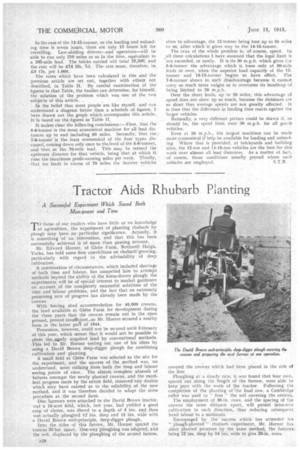Tractor Aids Rhubarb Planting A Successful Experiment Which Saved Both
Page 30

If you've noticed an error in this article please click here to report it so we can fix it.
Man-power and Time TO those of our readers who have little or no knowledge 1 of agriculture, the experiment of planting rhubarb by plough may have no particular significance. Actually, it is something of an innovation, and that this has been successfully achieved is of more than passing interest. Mr. Edward Homer, of Glebe Farm, Rothwell Haign, Yorks, has held some firm convictions on rhubarb'growing, particularly with regard to the advisability of deep cultivation.
A combination of circumstances, which included shortage of -both time and labour, has compelled him to attempt methods beyond the ability of the horse-drawn plough; the experiments. will be of special interest to market gardeners on account of the completely successful solutions Of the time and labour problems, and the fact that an extremely promising rate of progress has already been made by the crowns.
With forcing shed accommodation for 40,000 crowns, the land available at Glebe Farm for development during the three years that the crowns remain out in the open ground, proved insufficient,..so Mr. Horner secured a nearby farm in the latter part of 1944.
Possession, however, could not be secured until February of this year, which meant that it would not be possible to plant the =ply acquired land by conventional methods. This led to Mr. Horner testing out one of his ideas by using a David Brown deep-digger plough for combining cultivation and planting.
A small field at Glebe Farm was selected as the site for the experiment, and the success of the method was, we understand, most striking from both the time and 'labour saving points of view. The almost. complete .absenCe of failures amongst the newly planted crowns, and the excellent progress made by the entire field, removed any doubts which may have existed as to the reliability. of the new method, and it was therefore decided to adopt the same procedure at the second farm.
Disc harrows were attached to the David Brown tractor, lud a 16-acre field, which, last year, had yielded a good crop of clover, was disced to a depth of 4 ins. and then was actually ploughed 12 ins, deep and 15 ins, wide with a David Brown unit-principle, deep-digger plough. Into the sides of this furrow, Mr. Horner spaced the crowns 30'ins. apart. One-way 'ploughing was adepted, arid the soil, displaced by the ploughing of the second fiirrow, A28
covered the crowns which had been placed in the side of the .'first
Ploughing at a steady rate, it was found that four men, spaced out along the length of the furrow, were able to keep Pace with the work of the tractor. Following the completion of the planting of 'the final row, a Cambridge roller was used to " firm " the soil covering the crowns.
The 'employment of 30-in, rows, and the spacing of the crowns the same distance apart, will permit inter-row cultivation in each direction, thus reducing 3ubsequent hand labour to a minimum.
Encouraged by the success which. has attended his " plough-planted " rhubarb experiment, Mr. Horner has since planted potatoes by the same method, the furtoWs being 12 ins, deep' by 14 ins, Wide to give 28-in. rows:




















































